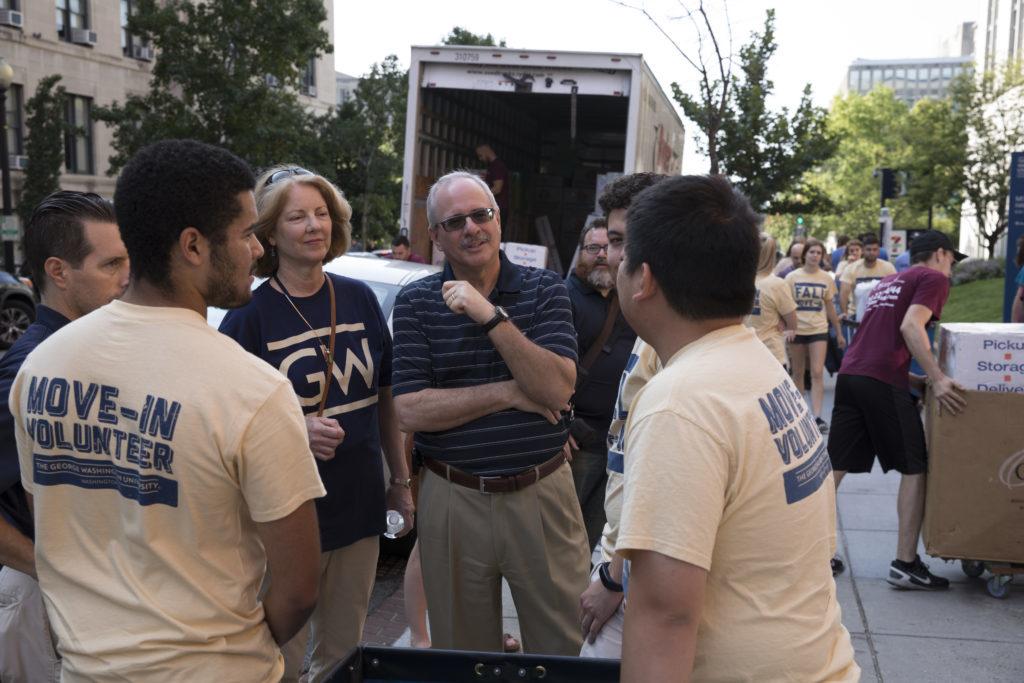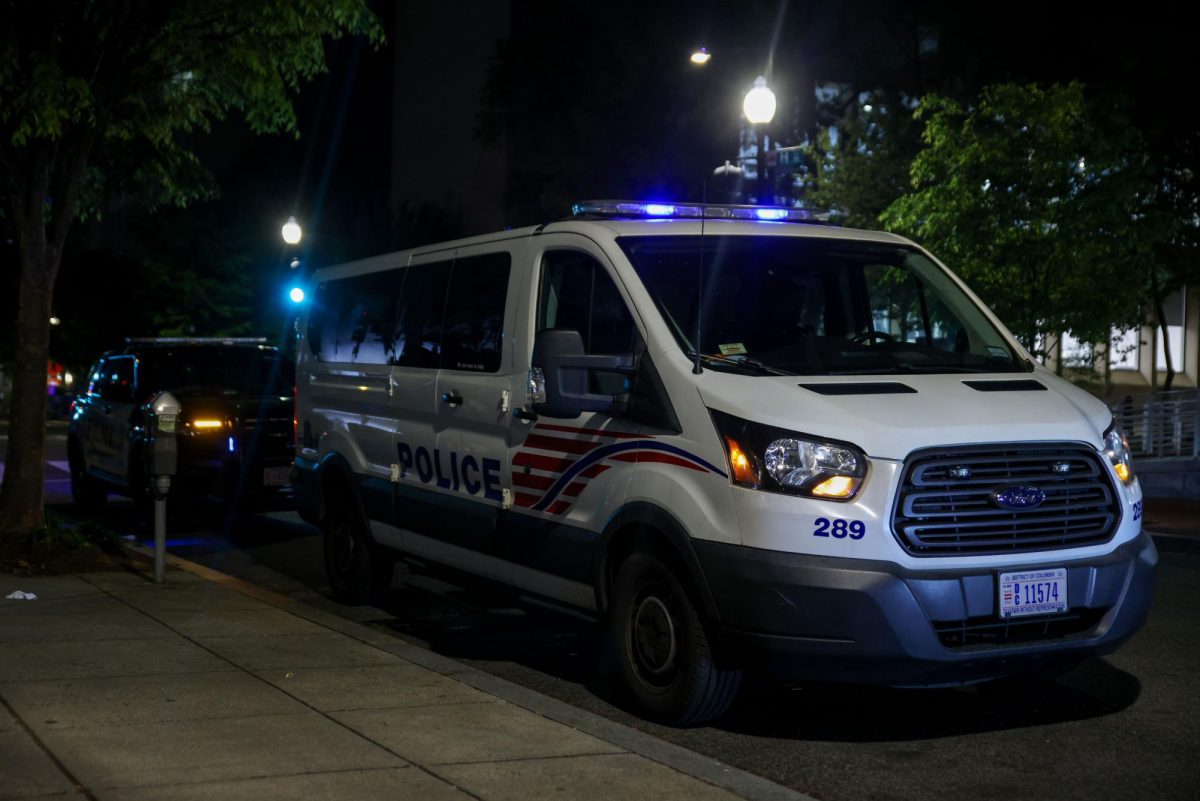University President Thomas LeBlanc said he would use his first year in office to begin a shift away from what he called a “bureaucratic” and at times impersonal culture at the University – a long-running gripe among students and faculty.
In his first sit-down interview with The Hatchet as University president, LeBlanc laid out a list of his top areas of interest – including research, fundraising and student retention – and signaled a desire to change the University’s entrenched bureaucracy. LeBlanc said much of his first year would be spent conducting a broad assessment of the University’s current position and said all of his major goals are likely to be multi-year efforts.
LeBlanc said he’s met with officials, trustees, students and faculty over the last several months to develop his vision for the University. Since arriving on campus Aug. 1, he said he’s toured residence halls and dined at campus eateries to get a sense of the student experience.
LeBlanc said he’s heard from students that they feel the University has a “risk-averse culture” that is often overly concerned with its finances when making decisions. He said the culture can hamstring students seeking help with financial aid or academic advising.
“I hear over and over again students feel like too much of their relationship with the University is transactional, and I hear from others within the University that every decision is entirely dominated by the financial impact,” he said.
LeBlanc said the issue was not with staff, but an overall campus atmosphere that encourages employees to follow a strict set of individualized rules and often doesn’t engage them in the overall mission of the University.
He said senior officials have to determine how the University can better serve students and faculty and then make policy changes – like revamping new staff orientations – to help achieve that goal.
Speaking about pressures facing the University under President Donald Trump’s administration, LeBlanc said GW wouldn’t consistently take sides in political debates but that officials should be prepared to defend “core values” in diversity and scientific research. LeBlanc’s first public statement on a national issue as University president was a condemnation of the violence at a white nationalist rally in Charlottesville, Va., which he called an act of racism and hate.
Since Trump was elected last November, some faculty and students have raised concerns about how his administration could impact research funding, international enrollment and undocumented students. Trump’s proposed budget last spring slashed funding for research agencies like the National Institutes of Health, and the Justice Department is reportedly preparing a legal assault against some affirmative action policies aimed at increasing diversity on college campuses.
“We have to understand what we’re doing and how it attaches to our core values, and more and more we’re being asked to defend what we’re doing,” he said.
Improving the undergraduate experience
LeBlanc said he would make student satisfaction one of his top priorities in his first year and expressed concern that the student dining plan might not be enough to cover the high cost of eating in Foggy Bottom. Although he hadn’t reached a final conclusion, he said it appeared dining was a large strain on students’ budgets.
“If you try to spread it out three meals a day, seven days a week, it’s very tight,” he said.
Officials switched to an “open” dining plan last academic year, closing the main dining hall on the Foggy Bottom campus, a change called for by student leaders.
But some students said the new plan – which allows students to spend dining money at restaurants and grocery stories across the area – did not offer enough dining funding to last for the semester. Officials added $200 to all dining budgets for students living on campus this academic year.
Like his predecessor, LeBlanc said he would focus on retention – the rate of students who remain at and graduate from the University – as a measure of student satisfaction on campus.
“If the students are happy here, if they are having a good experience, if they like the place, they’re more likely to stay until graduation,” he said. “And I want to make sure they stay and complete their degree.”
Top officials have made retention a major point of interest in recent years. In 2015, former University President Steven Knapp called it “an area of weakness” for the University. GW’s freshman retention rate has averaged 93 percent in recent years, putting it on par with its peers schools, but its six-year graduation rate – 83.7 percent for the class entering in 2010 – lags behind most of its competitors.
The Board of Trustees will assist LeBlanc in his effort to improve the student experience by creating task forces on student wellbeing and alumni engagement to form recommendations for improvement, Nelson Carbonell, the Board’s chair, said in an interview.
“I think a successful first year would be that when we get to this time next year we kind of all know where we’re heading and we’ve got people engaged in moving the University forward,” he said.
Taking stock after $1 billion
In the wake of the University’s historic $1 billion fundraising campaign, LeBlanc said his first year in charge will be a time to re-evaluate the University’s fundraising priorities and engagement with alumni donors.
LeBlanc said he has already brought in an outside expert to review the development office to compare how individual schools fared in reaching donation targets in the capital campaign and how GW’s fundraising arm matches up with competitors.
He said there is always concern after a University finishes a major fundraising blitz, like the $1 billion campaign, that officials will have exhausted potential sources of funding. But if GW has a “compelling vision,” there will be donors to fund it, he said.
There are currently no plans for another fundraising campaign, LeBlanc said, but he cited student aid and faculty recruitment as areas that will be hallmarks of any future effort. The capital campaign raised more than $170 million for student aid and more than $620 million for academics, including 23 endowed faculty positions.
“If you don’t have first-rate students, you don’t have first-rate faculty, then you’re not a first-rate university, by definition,” LeBlanc said.
A University transformed by research
After a decade of research growth under Knapp, LeBlanc said he would review the University’s research offerings to learn more about the investments that have been made and the impact that the projects have had on the University.
Before Knapp arrived in 2006, GW was ranked No. 114 on the National Science Foundation’s list of institutions with federal funding, with about $92 million in expenditures. In fiscal year 2015, the University moved up to No. 83, with $139 million in federal funding expenditures.
During that time, GW added an office of research and hired University of California neuroscientist Leo Chalupa to serve as the first vice president of research. All innovations in research need to be reevaluated to determine the University’s next steps, LeBlanc said.
“I just want to look at how we’re doing, sort of a progress check,” he said. “What kind of impact have we had, what kind of investments have we made and what do we want to do going forward over the next decade in that area?”
Colleen Grablick contributed reporting.





